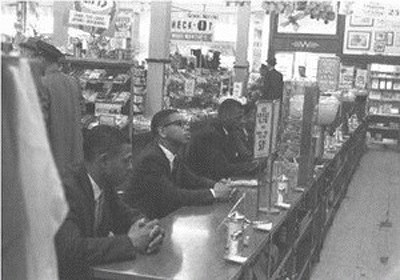Although trespassing and other legally dubious methods of accessing abandoned places are half the fun of exploring, it’s a welcomed relief when I occasionally have permission to be in said places. Earlier this summer, my friend Matt Lambros and I got permission to photograph the Paramount Theatre during the last leg of our road trip through the south. I never get tired of exploring, but I do get accustomed to it, which is why I expected the Paramount to be similar to the other southern theaters we’d seen prior to our arrival in Marshall, Texas.
Around 9am, we met up with the owner of the theater, who cautioned us about the state of decay the theater was in but let us shoot wherever we wanted. Structurally, the theater was similar to the previous ones -dilapidated balcony, dark stage, crumbling box seats- but the sunlight streaming in through holes in the roof was really spectacular.
The ceiling gets its blue color from being a simulated night sky. During operational years, when the lights were turned on behind the ceiling, twinkling stars appeared. There weren’t many of these ceilings at the time, and nowadays you mostly see them in shitty, bottle service type nightclubs. There is a working star ceiling at the Tabernacle of Prayer in Queens, NY, which used to be Loew’s Valencia Movie Palace. I’ve seen the church’s working star ceiling in person, and I gotta admit, it’s pretty delightful.
Spencer told us he purchased the theater in the 80s with the intention of turning it into a choir performance space. In the mean time, he used the theater as a recording studio and even turned the projection room into a makeshift apartment for himself.
Texas is part of the Bible Belt, so a choir performance space was viable plan, but it never came to fruition and Spencer eventually moved out and closed the building. He left behind a vast collection of instruments and recording equipment, as well as old movie paraphernalia and props from the building’s short stint as a country western dance hall.
Like many places in the south, the history of the Paramount is one of egregious racism. Opening in 1930, the theater had segregated bathrooms and the balcony was black only seating. There were two entrances, the front being the white entrance while the side doors around the corner served as the black entrance.
The ‘black entrance/exit’ on the balcony.
The theater played an influential role in the founding of the Congress of Racial Equality (CORE) in 1942. James Farmer, co-founder of CORE and patron of the Paramount, cited the theater’s “offending side entrance” as one of the motivations for the movement.
Beyond the theater, the town of Marshall was “the epicenter of [the Civil Rights Movement] in Texas.” On March 26th 1960, thirteen black college students conducted a sit-in at the whites only lunch counter at Woolworth’s. They were told the counter was closed, and repeated attempts of more sit-ins garnered the same response.
As racial tension increased in Marshall, some protests turned violent and dozens of black citizens were arrested for unlawful assembly. During this time, many businesses, rather than deal with the issue of segregation, simply closed up shop. Supposedly, the Woolworth’s in now a bar.
When Spencer acquired the theater in the 1980s, the seats had been removed and the front area turned into a dance floor for the dinner theater. Spencer, inspired by the acoustics of the room, used the space as a recording studio for many years. The decline of the recording industry and the economy eventually forced him to close the theater for good. As of June 2013, it was still on the market.
Water damage and the crumbling ceiling and walls made the box seats inaccessible and a bit of ceiling plaster fell while we were taking photos from the balcony. Matt takes forfuckingever to photograph theaters on account of being all “professional” about it, whatever that is, but it works out because my thing is taking forever to look through the piles of junk.
These amazing, hand-painted movie posters lined the dark hall to the main room of the theater. Unfortunately, the owner wasn’t willing to part with anything, including an original Gone With the Wind poster that’s just collecting dust.
Considering the state of the rest of the building, I’m surprised at the near-perfect condition of this statue and facade. By this point, the owner had left us to our own devices so I couldn’t pester him with questions so I don’t know when this was added to the theater.
A shot of the “blacks only” balcony from the main floor, with the racist side entrance on the right.
While waiting for Matt, the owner told me an amusing ghost story that was told to him by a visiting psychic (of which he was skeptical) about the disgruntled ghost of a man who was shot and killed on the main floor. Supposedly his name was Herman. HERMAN! That is the least menacing name for a ghost that never was.
To see more photos, go to the Paramount Theatre Flickr set
History source: The Texas Historical Commission
Disclaimer: If any information is incorrect, if you have more info, or if you’d just like to tell me something, feel free to contact me.
To support my work and see new comics, go here. To buy books, original artwork, merch, and more, visit my website store. Follow me on instagram.
























Sorry, the comment form is closed at this time.